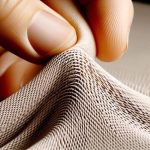When it comes to shrinking viscose, it's like exploring a labyrinth of possibilities – each turn holding the key to achieving the perfect fit for your garment.
But how does one even start this journey? Well, imagine a world where your oversized viscose piece transforms into a tailored dream with just a few simple steps.
Let's demystify the art of shrinking viscose together, revealing the secrets to success that will have you looking effortlessly stylish in no time.
Table of Contents
Key Takeaways
- Wash in hot water to shrink viscose effectively.
- Use high-heat drying to gradually restore fabric size.
- Iron damp fabric to relax fibers and resize.
- Monitor closely to prevent over-shrinking during the process.
Preparing the Viscose Garment
When shrinking viscose garments, I always recommend preparing the fabric by washing it in cold water and air-drying it flat to prevent any distortion in the material. Handling viscose requires gentle care to maintain its shape and quality. Before attempting to shrink a viscose garment, it's important to understand the nature of the fabric. Viscose is a semi-synthetic material that blends the comfort of natural fibers with the durability of synthetic ones. Its delicate nature means that it can easily lose its shape or shrink if not handled properly.
Garment preparation is key to achieving the desired results when shrinking viscose. Start by washing the garment in cold water to remove any dirt or residues that may affect the shrinking process. Avoid using hot water or harsh chemicals as they can damage the fabric. Once washed, gently squeeze out excess water and lay the garment flat to air dry. Avoid hanging viscose garments as this can stretch them out of shape. By following these steps, you can make sure that your viscose garment shrinks uniformly and retains its original quality.
Checking the Care Label
When it comes to caring for viscose garments, the care label holds valuable information that can guide us in preserving the fabric's quality.
By checking the care label, we can find important guidelines on how to handle the fabric, the recommended washing temperature, and other essential tips for maintaining the garment.
Understanding and following these care instructions can help guarantee that our viscose pieces remain in top condition for longer.
Care Label Guidelines
To guarantee the proper care of your viscose garments, always remember to check the care label guidelines before washing. Here are some key points to keep in mind:
- Shrinkage Prevention: Follow the manufacturer's instructions to prevent unwanted shrinkage when washing your viscose items.
- Garment Storage: Store your viscose garments in a cool, dry place to maintain their shape and prevent moisture-related damage.
- Moisture Control: Avoid excessive exposure to moisture to prevent the fabric from stretching or losing its original form.
Fabric Handling Tips
Upon checking the care label, it is important to handle viscose fabrics with care to maintain their quality and longevity. When dealing with viscose, understanding how it reacts to different handling methods is essential to avoid fabric shrinkage and prevent unwanted garment alterations. Here are some fabric handling tips to keep in mind:
| Handling Tips | Description |
|---|---|
| Hand Wash | Use mild detergent and cold water. |
| Air Dry | Avoid using the dryer to prevent shrinkage. |
| Steam Ironing | Use a low heat setting to avoid damaging the fabric. |
| Storage | Store in a cool, dry place to maintain quality. |
| Gentle Handling | Avoid wringing or twisting the fabric. |
Temperature and Washing
After reviewing the care label, let's discuss the importance of considering temperature and washing methods for maintaining viscose fabrics.
- Viscose shrinkage: Controlling the temperature is important to prevent viscose garments from shrinking excessively.
- Washing tips: Follow the care label instructions regarding water temperature and washing cycle settings to preserve the fabric.
- Fabric handling techniques: Gently wash viscose items by hand or using a delicate cycle to avoid damaging the fibers.
Washing in Hot Water
I've always wondered about the effectiveness of washing viscose in hot water. How does it impact the fabric's care and what tips can prevent shrinking?
Let's uncover these points to make sure we're caring for our viscose garments the best way possible.
Hot Water Effectiveness
Using hot water when washing viscose clothing can greatly enhance the effectiveness of the cleaning process. Hot water helps to break down dirt and oils more effectively, leading to a more thorough cleanse of the fabric.
Here are three key benefits of washing viscose in hot water:
- Improved Stain Removal: Hot water can help dissolve and lift tough stains from viscose fibers more easily.
- Better Odor Elimination: The heat from hot water can aid in removing any lingering odors trapped in the fabric.
- Enhanced Fabric Softness: Washing in hot water can help maintain the softness of viscose, especially when paired with a gentle fabric conditioner.
These advantages make hot water an excellent choice for cleaning viscose garments effectively.
Viscose Fabric Care
When caring for viscose fabric, washing it in hot water can greatly enhance the effectiveness of the cleaning process. Hot water helps to loosen dirt and grime, making it easier to remove stains from the fabric. Additionally, hot water can help kill bacteria and germs present on the fabric, providing a more thorough clean. To further improve the washing process, consider incorporating stain removal techniques and utilizing fabric softener benefits to keep the viscose fabric looking and feeling its best. Below is a table summarizing the benefits of washing viscose fabric in hot water:
| Benefits of Washing Viscose Fabric in Hot Water | ||
|---|---|---|
| Helps loosen dirt and grime | Enhances stain removal | Kills bacteria and germs |
Shrinking Tips
Wondering how washing viscose fabric in hot water can lead to shrinking? When it comes to fabric shrinking and garment care, washing your viscose items in hot water can be an effective method.
Here are some tips to keep in mind:
- Hot water aids in shrinking: Heat can cause the fibers in viscose fabric to contract, leading to shrinkage.
- Use a gentle detergent: Opt for a mild detergent to protect the fabric while still allowing it to shrink effectively.
- Avoid excessive agitation: To prevent damage to the garment, use a gentle cycle or hand wash when shrinking viscose in hot water.
Drying on High Heat
Upon drying viscose on high heat, be cautious as it may lead to significant shrinkage of the fabric. When exposed to high temperatures, viscose fibers can tighten and contract, causing the material to shrink significantly. It is important to handle viscose garments with care during the drying process to avoid unwanted shrinkage.
To illustrate the impact of high heat drying on viscose, consider the following table that compares the effects of different drying methods:
| Drying Method | Shrinkage Level | Fabric Condition |
|---|---|---|
| High Heat | High | Prone to damage |
| Air Drying | Low | Gentle |
| Low Heat | Medium | Safe |
| Tumble Dry | High | Risk of shrinkage |
As shown in the table, drying viscose on high heat can result in significant shrinkage and potential damage to the fabric. Opting for gentler drying methods like air drying or using low heat settings can help preserve the quality of the viscose material while reducing the risk of shrinkage.
Repeating the Process if Needed
If you've noticed any shrinkage after drying viscose on high heat, you may think about repeating the process if needed to help restore the fabric's original size.
Here are some strategies to think about:
- Re Washing Technique: If the fabric has shrunk but not enough, think about running it through another washing cycle on high heat. Sometimes, multiple cycles can gradually bring the fabric back to its original dimensions.
- Time-Saving Options: For a quick fix, you can try a shorter drying period on high heat to see if the fabric relaxes and regains some of its original size. This can be a more efficient way to test if further shrinking is possible without committing to a full wash cycle.
- Careful Monitoring: Keep a close eye on the fabric during each repeat process to make sure you don't over-shrink it. By monitoring the fabric closely, you can make adjustments as needed and prevent excessive shrinkage.
Ironing the Shrunk Fabric
To effectively address the issue of shrunk fabric, I recommend ironing the fabric to help relax the fibers and potentially restore its original size. Ironing can be an important step in the process of resizing viscose garments. Here are some fabric stretching and ironing techniques that can aid in this endeavor:
| Fabric Stretching | Ironing Techniques |
|---|---|
| 1. Use a spray bottle to dampen the fabric slightly before ironing. | 1. Set your iron to the appropriate heat setting for viscose (usually a low to medium heat). |
| 2. Gently pull the fabric while ironing to encourage stretching. | 2. Place a damp cloth between the iron and the fabric to prevent direct heat exposure. |
| 3. Hang the garment to cool after ironing to help set the fibers in the stretched position. | 3. Iron in sections, moving the iron in a continuous motion to avoid creating creases. |
| 4. Repeat the process if needed until the desired size is achieved. | 4. Avoid pressing too hard on the fabric to prevent damage. |
These garment maintenance and fabric care tips can be instrumental in reviving your shrunk viscose items.
Final Fitting and Adjustments
After ironing the shrunk fabric, the next step involves making any final fitting and adjustments to guarantee the garment fits properly. Here are three essential techniques for achieving the perfect fit after fabric shrinkage and garment alteration:
- Pin and Try Method:
Start by pinning any areas where the garment feels loose or ill-fitting. Try on the garment and make adjustments as needed. This method allows for precise alterations tailored to your body shape.
- Seam Reinforcement:
Reinforce seams that may have been affected by the shrinking process. This can involve restitching seams, adding darts, or adjusting the hemline to assure a clean and polished look.
- Evaluation and Reevaluation:
After making initial adjustments, evaluate the garment by trying it on again. Walk around, sit, and move in different positions to guarantee comfort and proper fit. Reevaluate any areas that still feel off and make necessary modifications for a flawless final result.
Frequently Asked Questions
Can I Use a Fabric Softener or Dryer Sheets When Shrinking Viscose?
I wouldn't recommend using fabric softener or dryer sheets for shrinking viscose. Fabric softeners may not be effective for this purpose. Instead, consider alternative methods like adjusting the washing and drying settings to achieve the desired shrinkage.
Will Shrinking Viscose Cause It to Lose Its Color or Fade?
Shrinking viscose can lead to color loss or fading. To preserve color, control shrinkage by following care instructions. Avoid excessive heat or agitation. Using gentle detergents and air-drying can help prevent fading and maintain vibrancy.
Is It Possible to Control How Much Viscose Shrinks During the Process?
Controlling shrinkage in viscose involves specific techniques like cold water washing and air drying. Following garment care instructions can help manage the shrinkage process. It's important to handle viscose with care to maintain its quality.
How Long Should I Wait Before Trying on the Garment After Shrinking It?
After shrinking the garment, I typically wait a bit before trying it on for comfort. This waiting period allows me to adjust the sizing if needed. It is crucial to make sure the garment fits well after the shrinking process.
Can I Use a Steamer Instead of Ironing to Shrink Viscose Fabric?
Using a steamer to shrink viscose is effective, but not as controllable as ironing. While both methods can shrink the fabric, steaming is gentler for fabric care. Consider the level of shrinkage control needed.
- Tetron Fabric for Marine Applications: Durability and Use Cases - June 18, 2025
- Tetron Fabric for Outdoor Furniture: Weather Resistance and Care - June 18, 2025
- Tetron Fabric for Wall Coverings: Style and Application Tips - June 18, 2025





